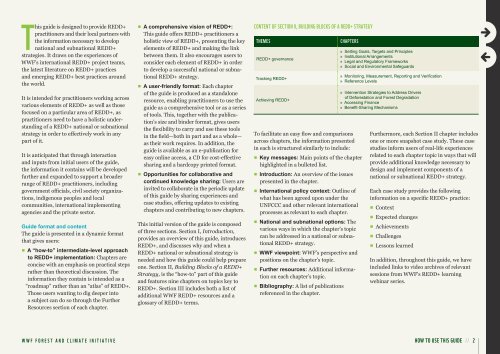WWF Guide to Building REDD+ Strategies
WWF Guide to Building REDD+ Strategies
WWF Guide to Building REDD+ Strategies
Create successful ePaper yourself
Turn your PDF publications into a flip-book with our unique Google optimized e-Paper software.
this guide is designed <strong>to</strong> provide <strong>REDD+</strong><br />
practitioners and their local partners with<br />
the information necessary <strong>to</strong> develop<br />
national and subnational <strong>REDD+</strong><br />
strategies. It draws on the experiences of<br />
<strong>WWF</strong>’s international <strong>REDD+</strong> project teams,<br />
the latest literature on <strong>REDD+</strong> practices<br />
and emerging <strong>REDD+</strong> best practices around<br />
the world.<br />
It is intended for practitioners working across<br />
various elements of <strong>REDD+</strong> as well as those<br />
focused on a particular area of <strong>REDD+</strong>, as<br />
practitioners need <strong>to</strong> have a holistic understanding<br />
of a <strong>REDD+</strong> national or subnational<br />
strategy in order <strong>to</strong> effectively work in any<br />
part of it.<br />
It is anticipated that through interaction<br />
and inputs from initial users of the guide,<br />
the information it contains will be developed<br />
further and expanded <strong>to</strong> support a broader<br />
range of <strong>REDD+</strong> practitioners, including<br />
government officials, civil society organizations,<br />
indigenous peoples and local<br />
communities, international implementing<br />
agencies and the private sec<strong>to</strong>r.<br />
<strong>Guide</strong> format and content<br />
The guide is presented in a dynamic format<br />
that gives users:<br />
n A “how-<strong>to</strong>” intermediate-level approach<br />
<strong>to</strong> <strong>REDD+</strong> implementation: Chapters are<br />
concise with an emphasis on practical steps<br />
rather than theoretical discussion. The<br />
information they contain is intended as a<br />
“roadmap” rather than an “atlas” of <strong>REDD+</strong>.<br />
Those users wanting <strong>to</strong> dig deeper in<strong>to</strong><br />
a subject can do so through the Further<br />
Resources section of each chapter.<br />
n A comprehensive vision of <strong>REDD+</strong>:<br />
This guide offers <strong>REDD+</strong> practitioners a<br />
holistic view of <strong>REDD+</strong>, presenting the key<br />
elements of <strong>REDD+</strong> and making the link<br />
between them. It also encourages users <strong>to</strong><br />
consider each element of <strong>REDD+</strong> in order<br />
<strong>to</strong> develop a successful national or subnational<br />
<strong>REDD+</strong> strategy.<br />
n A user-friendly format: Each chapter<br />
of the guide is produced as a standalone<br />
resource, enabling practitioners <strong>to</strong> use the<br />
guide as a comprehensive <strong>to</strong>ol or as a series<br />
of <strong>to</strong>ols. This, <strong>to</strong>gether with the publication’s<br />
size and binder format, gives users<br />
the flexibility <strong>to</strong> carry and use these <strong>to</strong>ols<br />
in the field—both in part and as a whole—<br />
as their work requires. In addition, the<br />
guide is available as an e-publication for<br />
easy online access, a CD for cost-effective<br />
sharing and a hardcopy printed format.<br />
n Opportunities for collaborative and<br />
continued knowledge sharing: Users are<br />
invited <strong>to</strong> collaborate in the periodic update<br />
of this guide by sharing experiences and<br />
case studies, offering updates <strong>to</strong> existing<br />
chapters and contributing <strong>to</strong> new chapters.<br />
This initial version of the guide is composed<br />
of three sections. Section I, Introduction,<br />
provides an overview of this guide, introduces<br />
<strong>REDD+</strong>, and discusses why and when a<br />
<strong>REDD+</strong> national or subnational strategy is<br />
needed and how this guide could help prepare<br />
one. Section II, <strong>Building</strong> Blocks of a <strong>REDD+</strong><br />
Strategy, is the “how-<strong>to</strong>” part of this guide<br />
and features nine chapters on <strong>to</strong>pics key <strong>to</strong><br />
<strong>REDD+</strong>. Section III includes both a list of<br />
additional <strong>WWF</strong> <strong>REDD+</strong> resources and a<br />
glossary of <strong>REDD+</strong> terms.<br />
Content oF SeCtion ii, BuildinG BloCkS oF a Redd+ StRateGy<br />
tHemeS CHaPteRS<br />
<strong>REDD+</strong> governance<br />
Tracking <strong>REDD+</strong><br />
Achieving <strong>REDD+</strong><br />
To facilitate an easy flow and comparisons<br />
across chapters, the information presented<br />
in each is structured similarly <strong>to</strong> include:<br />
n Key messages: Main points of the chapter<br />
highlighted in a bulleted list.<br />
n Introduction: An overview of the issues<br />
presented in the chapter.<br />
n International policy context: Outline of<br />
what has been agreed upon under the<br />
UNFCCC and other relevant international<br />
processes as relevant <strong>to</strong> each chapter.<br />
n National and subnational options: The<br />
various ways in which the chapter’s <strong>to</strong>pic<br />
can be addressed in a national or subnational<br />
<strong>REDD+</strong> strategy.<br />
n <strong>WWF</strong> viewpoint: <strong>WWF</strong>’s perspective and<br />
positions on the chapter’s <strong>to</strong>pic.<br />
n Further resources: Additional information<br />
on each chapter’s <strong>to</strong>pic.<br />
n Bibliography: A list of publications<br />
referenced in the chapter.<br />
» Setting Goals, Targets and Principles<br />
» Institutional Arrangements<br />
» Legal and Regula<strong>to</strong>ry Frameworks<br />
» Social and Environmental Safeguards<br />
» Moni<strong>to</strong>ring, Measurement, Reporting and Verification<br />
» Reference Levels<br />
» Intervention <strong>Strategies</strong> <strong>to</strong> Address Drivers<br />
of Deforestation and Forest Degradation<br />
» Accessing Finance<br />
» Benefit-Sharing Mechanisms<br />
Furthermore, each Section II chapter includes<br />
one or more snapshot case study. These case<br />
studies inform users of real-life experiences<br />
related <strong>to</strong> each chapter <strong>to</strong>pic in ways that will<br />
provide additional knowledge necessary <strong>to</strong><br />
design and implement components of a<br />
national or subnational <strong>REDD+</strong> strategy.<br />
Each case study provides the following<br />
information on a specific <strong>REDD+</strong> practice:<br />
n Context<br />
n Expected changes<br />
n Achievements<br />
n Challenges<br />
n Lessons learned<br />
In addition, throughout this guide, we have<br />
included links <strong>to</strong> video archives of relevant<br />
sessions from <strong>WWF</strong>'s <strong>REDD+</strong> learning<br />
webinar series.<br />
<strong>WWF</strong> FOREST AND CLIMATE INITIATIVE HoW <strong>to</strong> uSe tHiS <strong>Guide</strong> // 2

















